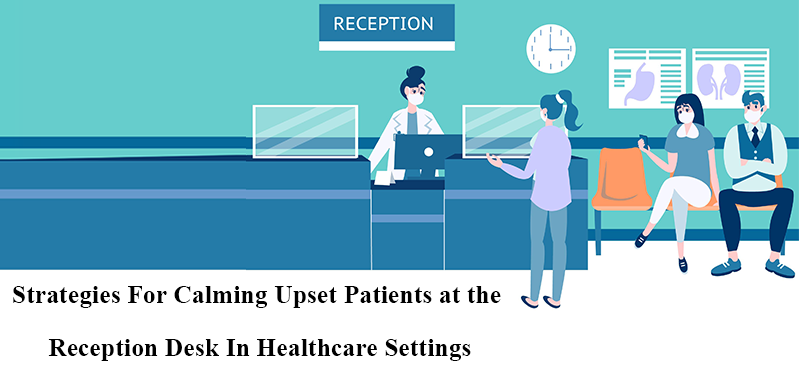
Strategies, for Calming Upset Patients at the Reception Desk, in Healthcare Settings
The reception area in healthcare facilities is the interaction point for patients. It's common for patients to express their frustrations there when feeling anxious, in pain, or upset. For receptionists, managing these situations with poise and professionalism can be key in calming tempers and averting disputes.
This piece provides tips for healthcare workers to handle challenging encounters successfully across various roles, such as front desk receptionist or office manager, to enhance interactions between staff and patients and improve the overall experience.
Reasons Why Patients Express Anger – and Effective Ways to Address Their Concerns
Patients may feel upset for some reason. It's crucial to grasp these triggers in order to handle them properly. Rage often stems from underlying issues or misinterpretations. Acknowledging the reason enables staff to react with compassion and problem-solving skills, which can help calm the situation down.
Common factors that often lead to annoyance are;
- Patients may become frustrated when faced with wait times at the doctor's office or hospital—especially when they are feeling unwell or anxious.
- Issues with billing and insurance can cause stress due to misunderstandings regarding costs and coverage or expectations for payment.
- Lack of communication can frustrate patients who feel uninformed about their treatment plans or upcoming appointments.
- Dealing with stress or health worries can cause patients to arrive feeling anxious or overwhelmed, by their health condition and more sensitive, to concerns.
The Critical Need for De-Escalation Skills among Front Desk Staff
Touching base with the front desk staff helps the patients be sure of how the doctor’s services will be. Apparently, the threats of escalated unpleasant interactions can be avoided if patients are taught how to control themselves. With the right approaches, patients, no matter how frustrated they feel, can be made to feel respected by listening to them and making them interested in a peaceful settlement. One reason conflict-resolving strategies need to be incorporated is training. ‘Managing Angry Customers at the Front Desk,’ a course for the health care team imposed on patients, provides inadequate return management resolution support for patient-centered service.
Five techniques that can be used to address anger in patients
There are five plausible approaches and ways of achieving concerns from your front desk staff and resolving anger where all negative emotions are absent and resolving interactions does not lead to further insult:
1. Calm Down And Pay Attention Throughout
Whence a patient is angry, the common reaction or response is to defend oneself in campaigns. Nevertheless, remaining cool and composed is highly important. Allow the patient to have their say without interruptions fully. In this sense, you are better demonstrating that their problems to them as concerns are important.
2. Recognize The Emotional Strain They Are Under
Unfortunately, they are simply looking for their emotions to be acknowledged. Hearing someone say, “I understand why you’re a bit annoyed with this,” will be enough Intraday. Defensive explanations should not be made. Empathy and support should be emphasized instead.
3. Explain What Went Wrong and Why, Rather Than Making Excuses
After a patient has felt understood, attempt to change the dynamics of the conversation to solve the problem. Providing a practical problem, even if it’s simply to reschedule an appointment or explain a billing concern, helps create progress in the conversation and lessens aggravation.
4. Do Not Be Shy But Remain Professional
Patience is a virtue but there are limits. If a patient starts to yell or verbally assault a member of the health care team, they simply have to inform the person that such behavior is inappropriate and unacceptable. Let them understand that, though you would like to assist, the discussion has to be civil.
5. When It Comes to Offending or Upsetting the Client’s Sense of Security
Some instances occur when there are unreasonable odds that a manager or supervisor may need to come in. Empower your staff to know when they should call for help because many things tend to calm down, especially when they become out of control or dangerous. That is why staff is equipped with protocols that they know can handle escalated cases.
The Impact of Body Language
Although it is apparent that most healthcare team members rely on what they say to the patient, there are instances when a patient is upset, and words will not help, but nonverbal communication will. Staff members need to be aware of their physical behavior in the course of the interaction. Simple actions such as burying one’s eyes in the patient’s eyes and nodding, as well as having one’s body open, can build rapport and make the patient feel understood.
On the other hand, folding arms, twiddling thumbs, or tapping feet may trigger even more anger in the frustrated patient. Teaching staff about awareness of those gestures is something every patient will benefit from when interacting with them.
What is the potential benefit of attending the "Defusing Angry Patients at the Front Desk" Webinar?
At the Conference Panel, we help health workers acquire the competencies they require to handle difficult situations. In our “Defusing Angry Patients at the Front Desk” webinar, we provide an advanced approach to Conflict Management, so front desk staff will be well-versed in effective approaches to preventing and pacifying patients’ problems.





